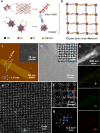Single-layer cluster ionic-chain networks with tetragonal pores
- PMID: 40592907
- PMCID: PMC12215711
- DOI: 10.1038/s41467-025-60879-y
Single-layer cluster ionic-chain networks with tetragonal pores
Abstract
Two-dimensional (2D) materials with intrinsic pores have attracted attention for catalytic and electronic applications. However, a significant gap exists between all-inorganic 2D networks with inorganic connectors and those with organic connectors due to the greater complexity of functionalizing inorganic molecules. Addressing this gap, we present a new class of 2D all-inorganic porous networks: single-layer cluster ionic-chain networks (CINs), constructed by using PW10M2 (M = Mn, Co) polyoxometalate (POM) clusters as nodes and end-capping agents for ionic chains. The integration of POM clusters into these networks significantly alters the electronic and band structures. Notably, the Mn-based CIN exhibits extremely high catalytic activity, achieving a toluene oxidation conversion rate of over 1.45 mmol g-1 h-1. Calculations suggest that POM clusters act as an 'electron buffer', stabilizing electron density at Mn sites and lowering the activation energy for toluene oxidation. This development showcases POM clusters as 'superatom' capping agents, establishing a pathway for all-inorganic 2D networks that could advance new catalytic materials with unique electronic properties.
© 2025. The Author(s).
Conflict of interest statement
Competing interests: The authors declare no competing interests.
Figures




 ), PW10Mn2 clusters (
), PW10Mn2 clusters ( ), and Mn-CIN (
), and Mn-CIN ( ). Reaction conditions: 50 °C, 6 h. c The toluene conversion catalyzed by Mn-CIN at 50°C over 18 h. d Catalytic durability for Mn-CIN. Reaction conditions: 50 °C, 3 h. e The conversion rate of toluene oxidation for Mn-CIN at different temperatures for 3 h. f The toluene conversion rate of Mn-CIN compared with other reported systems for toluene oxidation.
). Reaction conditions: 50 °C, 6 h. c The toluene conversion catalyzed by Mn-CIN at 50°C over 18 h. d Catalytic durability for Mn-CIN. Reaction conditions: 50 °C, 3 h. e The conversion rate of toluene oxidation for Mn-CIN at different temperatures for 3 h. f The toluene conversion rate of Mn-CIN compared with other reported systems for toluene oxidation.
Similar articles
-
Systemic pharmacological treatments for chronic plaque psoriasis: a network meta-analysis.Cochrane Database Syst Rev. 2017 Dec 22;12(12):CD011535. doi: 10.1002/14651858.CD011535.pub2. Cochrane Database Syst Rev. 2017. Update in: Cochrane Database Syst Rev. 2020 Jan 9;1:CD011535. doi: 10.1002/14651858.CD011535.pub3. PMID: 29271481 Free PMC article. Updated.
-
Sertindole for schizophrenia.Cochrane Database Syst Rev. 2005 Jul 20;2005(3):CD001715. doi: 10.1002/14651858.CD001715.pub2. Cochrane Database Syst Rev. 2005. PMID: 16034864 Free PMC article.
-
Systemic pharmacological treatments for chronic plaque psoriasis: a network meta-analysis.Cochrane Database Syst Rev. 2021 Apr 19;4(4):CD011535. doi: 10.1002/14651858.CD011535.pub4. Cochrane Database Syst Rev. 2021. Update in: Cochrane Database Syst Rev. 2022 May 23;5:CD011535. doi: 10.1002/14651858.CD011535.pub5. PMID: 33871055 Free PMC article. Updated.
-
Nutritional interventions for survivors of childhood cancer.Cochrane Database Syst Rev. 2016 Aug 22;2016(8):CD009678. doi: 10.1002/14651858.CD009678.pub2. Cochrane Database Syst Rev. 2016. PMID: 27545902 Free PMC article.
-
Intravenous magnesium sulphate and sotalol for prevention of atrial fibrillation after coronary artery bypass surgery: a systematic review and economic evaluation.Health Technol Assess. 2008 Jun;12(28):iii-iv, ix-95. doi: 10.3310/hta12280. Health Technol Assess. 2008. PMID: 18547499
References
-
- Tan, C. et al. Recent advances in ultrathin two-dimensional nanomaterials. Chem. Rev.117, 6225–6331 (2017). - PubMed
-
- Zhao, X. et al. Engineering covalently bonded 2D layered materials by self-intercalation. Nature581, 171–177 (2020). - PubMed
-
- Leng, K. et al. Molecularly thin two-dimensional hybrid perovskites with tunable optoelectronic properties due to reversible surface relaxation. Nat. Mater.17, 908–914 (2018). - PubMed
-
- Chen, T.-A. et al. Wafer-scale single-crystal hexagonal boron nitride monolayers on Cu (111). Nature579, 219–223 (2020). - PubMed
-
- Hou, L. et al. Synthesis of a monolayer fullerene network. Nature606, 507–510 (2022). - PubMed
Grants and funding
LinkOut - more resources
Full Text Sources
Miscellaneous

